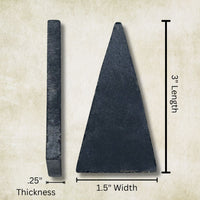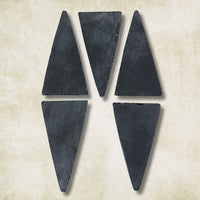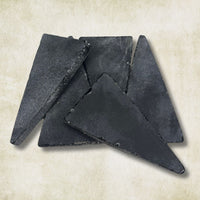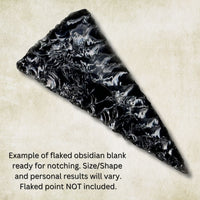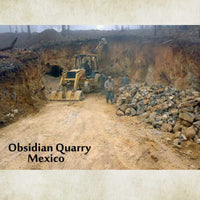Black Obsidian Preshape Slab - 3" Triangle Profile
Small triangle shaped black obsidian blank for making arrowheads. Sold individually.
Approx. 3" long, 1.5" wide, .25"-.31" thick. These are hand trimmed so sizes are approximate.
This preshaped slab can be pressure flaked as is, or serve as a solid starting point for flake-over-grind techniques.
Slabs and preshapes are cut with diamond lapidary saws of #1 graded material. Black Obsidian is a popular volcanic glass favored by flintknappers for its consistent quality and uniform flaking. Knappers who favor pressure flaking techniques usually enjoy Obsidian in particular for its potential to run long, uniform flakes.
WARNING: Obsidian flakes can be sharper than razor blades! Exercise extreme caution!
General Information on Obsidian
Obsidian is mineral-like, but not a true mineral because as a glass it is not crystalline; in addition, its composition is too complex to comprise a single mineral. It is sometimes classified as a mineraloid. Pure obsidian is usually dark in appearance, though the color varies depending on the presence of impurities. Iron and magnesium typically give the obsidian a dark green to brown to black color. Very few samples are nearly colorless. In some stones, the inclusion of small, white, radially clustered crystals of cristobalite in the black glass produce a blotchy or snowflake pattern (snowflake obsidian). It may contain patterns of gas bubbles remaining from the lava flow, aligned along layers created as the molten rock was flowing before being cooled. These bubbles can produce interesting effects such as a golden sheen (sheen obsidian) or an iridescent, rainbow-like sheen (rainbow obsidian).
Obsidian can be found in locations which have experienced rhyolitic eruptions. It can be found in Argentina, Armenia, Azerbaijan, Canada, Chile, Greece, El Salvador, Guatemala, Iceland, Italy, Japan, Kenya, Mexico, New Zealand, Peru, Scotland and United States. Obsidian flows which may be hiked on are found within the calderas of Newberry Volcano and Medicine Lake Volcano in the Cascade Range of western North America, and at Inyo Craters east of the Sierra Nevada in California. Yellowstone National Park has a mountainside containing obsidian located between Mammoth Hot Springs and the Norris Geyser Basin, and deposits can be found in many other western U.S. states including Arizona, Colorado, New Mexico, Texas, Utah, Washington, Oregon and Idaho. Obsidian can also be found in the eastern U.S. state of Virginia.
Obsidian was valued in Stone Age cultures because, like flint, it could be fractured to produce sharp blades or arrowheads. Like all glass and some other types of naturally occurring rocks, obsidian breaks with a characteristic conchoidal fracture. It was also polished to create early mirrors. Modern archaeologists have developed a relative dating system, obsidian hydration dating, to calculate the age of obsidian artifacts.
Lithic analysis can be instrumental in understanding prehispanic groups in Mesoamerica. A careful analysis of obsidian in a culture or place can be of considerable use to reconstruct commerce, production, distribution and thereby understand economic, social and political aspects of a civilization. This is the case in Yaxchilán, a Maya city where even warfare implications have been studied linked with obsidian use and its debris. Another example is the archeological recovery at coastal Chumash sites in California indicating considerable trade with the distant site of Casa Diablo, California in the Sierra Nevada Mountains.
Pre-Columbian Mesoamericans' use of obsidian was extensive and sophisticated; including carved and worked obsidian for tools and decorative objects. Mesoamericans also made a type of sword with obsidian blades mounted in a wooden body. Called a macuahuitl, the weapon was capable of inflicting terrible injuries, combining the sharp cutting edge of an obsidian blade with the ragged cut of a serrated weapon.
Native American people traded obsidian throughout the Americas. Each volcano and in some cases each volcanic eruption produces a distinguishable type of obsidian, making it possible for archaeologists to trace the origins of a particular artifact. Similar tracing techniques have allowed obsidian to be identified in Greece also as coming from Melos, Nisyros or Yiali, islands in the Aegean Sea. Obsidian cores and blades were traded great distances inland from the coast.
In Chile obsidian tools from Chaitén Volcano have been found as far away as in Chan-Chan 400 km north of the volcano and also in sites 400 km south of it.








